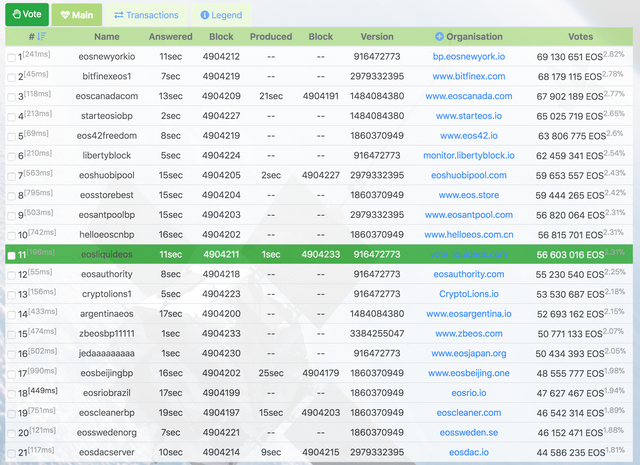Part 1: Using Python To Make API Requests To EOS Public API Endpoints

This tutorial is the first part of a series where different aspects of programming with EOS are explained. This part will explain how to find public api_endpoints and interact with them using Python.
Repository
What will I learn
- Find a public API endpoint
- Perform GET requests
- Perform POST requests
Requirements
- Python3.6
Difficulty
- basic
Tutorial
Setup
Download the files from Github. There is 2 files get_info.py and get_block.py which takes 1 argument block_id.
Run scripts as following:
> python get_info.py
> python get_block.py 5
Find a public API endpoint
EOS uses 21 block producers(BP) which are known to everyone. There are network monitoring tools like the website eosnetworkmonitor where this information is published live.

However, finding the public api's for each BP requires a bit more digging. Every BP is required to host a file bp.json which can be found by taking their public url and adding /bp.json to it like bp.eosnewyork.io + \bp.json = bp.eosnewyork.io/bp.json. In this file at the bottom information about the api_endpoint is located. These api_endpoint's can be used to make API calls with for example python. In this example http://api.eosnewyork.io will be used in conjunction with Python.
{
"producer_account_name": "eosnewyorkio",
"producer_public_key": "EOS6GVX8eUqC1gN1293B3ivCNbifbr1BT6gzTFaQBXzWH9QNKVM4X",
"org": {
"candidate_name": "EOS New York",
"website": "https://www.eosnewyork.io",
"code_of_conduct": "https://steemit.com/eos/@eosnewyork/eos-new-york-code-of-conduct",
"ownership_disclosure": "https://steemit.com/eos/@eosnewyork/eos-new-york-ownership-disclosure-and-corporate-structure",
"email": "[email protected]",
"branding": {
"logo_256": "https://bp.eosnewyork.io/Logo_256.jpg",
"logo_1024": "https://bp.eosnewyork.io/Logo_1024.jpg",
"logo_svg": "https://bp.eosnewyork.io/eosnewyorkio.svg"
},
"location": {
"name": "Cook Islands",
"country": "CK",
"latitude": -18.857952,
"longitude": -159.785278
},
"social": {
"steemit": "eosnewyork",
"twitter": "eosnewyork",
"youtube": "UCg7aeCSXUTP49w_elxgYIXA",
"facebook": "eosnewyorkBP",
"github": "eosnewyork",
"reddit": "eosnewyork",
"keybase": "d3ck",
"telegram": "eosnewyorkchat",
"wechat": "kevineosnewyork"
}
},
"nodes": [
{
"location": {
"name": "primary",
"country": "BR",
"latitude": -23.5505,
"longitude": -46.6333
},
"is_producer": false,
"node_type": "full",
"p2p_endpoint": "node1.eosnewyork.io:6987",
"api_endpoint": "http://api.eosnewyork.io",
"ssl_endpoint": "https://api.eosnewyork.io"
}
]
}
bp.eosnewyork.io/bp.json
Note: Not every BP has an api_endpoint
Perform GET requests
A full list of all possible API requests can be found here. They fall into one of two categories. GET and POST requests. To handle these API calls the requests library is used.
import requests
The url consists of the api_endpoint concatenated with the api_request. Performing a GET request returns a json structure which has to be decoded before printing.
api_endpoint = 'http://api.eosnewyork.io'
api_request = '/v1/chain/get_info'
url = api_endpoint + api_request
print(requests.get(url=url).json())
Perform POST requests
The difference between the a POST and a GET request is that for a POST data is posted to the server which then results into a text response. Normally a dictionary containing the variables would have been sufficient, however the EOS nodes only accept a string of the dict. In this example the dict {"block_num_or_id": <block_id> } is posted to the server. The parameters can be changed to retrieve different data.
block = int(sys.argv[1])
api_endpoint = 'http://api.eosnewyork.io'
api_request = '/v1/chain/get_block'
url = api_endpoint + api_request
parameters = '{"block_num_or_id":' + f'{block}' + '}'
print(requests.post(url=url, data=parameters).text)
Running the code
get_info.py performs the get_info API GET request and prints the result to the terminal.
python get_info.py
{
'server_version': '36a043c5',
'chain_id': 'aca376f206b8fc25a6ed44dbdc66547c36c6c33e3a119ffbeaef943642f0e906',
'head_block_num': 4911490,
'last_irreversible_block_num': 4911158,
'last_irreversible_block_id': '004af036cb65d7c24ce811268bcf404631f27a9d5004a23001bee1679f1445ea',
'head_block_id': '004af18275beff4a40c62baed070802fae40d1245cd11abea6d46b1df1efe223',
'head_block_time': '2018-07-09T03:23:34.000',
'head_block_producer': 'eoscanadacom',
'virtual_block_cpu_limit': 200000000,
'virtual_block_net_limit': 1048576000,
'block_cpu_limit': 199900,
'block_net_limit': 1048576
}
get_block.py takes 1 argument, the block_id and perform the API get_block POST request. Printing the requested block to the terminal.
python get_block.py 5
{
"timestamp": "2018-06-09T11:56:31.500",
"producer": "eosio",
"confirmed": 0,
"previous": "00000004faa09f2b6f59515121772032f080c12120d7e4b42c3b9569fb2a9a58",
"transaction_mroot": "0000000000000000000000000000000000000000000000000000000000000000",
"action_mroot": "40574fe525741beb36f4976e41ff902d1d31a684e53bcefefbf2e64648348108",
"schedule_version": 0,
"new_producers": null,
"header_extensions": [],
"producer_signature": "SIG_K1_K2j4PdYU28EJ5LAVeXxYjZY3uG1qtz4JF41sakGYPskpXDGotaen1A2sReh5dnHTTH1puZ5cMiGpGt2KTZBqTKCEHoJAr3",
"transactions": [],
"block_extensions": [],
"id": "00000005c7424e57fd4fd8a6af3c612b1141c1dac23484c9258e7ecffcdbd5a6",
"block_num": 5,
"ref_block_prefix": 2799194109
}
The code for this tutorial can be found on GitHub!
This tutorial was written by @juliank.
Hello, thanks for covering tutorial about EOS. I'm really new in blockchain development but after reading a little bit about EOS documentation, seems it's possible to do smart contract by binding it using Cython or just using C FFI for Python. What do you think 🙂?
Hey @drsensor
Here's a tip for your valuable feedback! @Utopian-io loves and incentivises informative comments.
Contributing on Utopian
Learn how to contribute on our website.
Want to chat? Join us on Discord https://discord.gg/h52nFrV.
Vote for Utopian Witness!
Thank you for your contribution.
Your contribution has been evaluated according to Utopian policies and guidelines, as well as a predefined set of questions pertaining to the category.
To view those questions and the relevant answers related to your post, click here.
Need help? Write a ticket on https://support.utopian.io/.
Chat with us on Discord.
[utopian-moderator]
Thanks for the feedback, I will do that
I am a bit (pleasantly) surprised to see this tutorial. I thought EOS was all about C++. Could you tell us a bit more on possible limitations or is everything possible? Thanks.
To be honest I am not sure yet. Basically writing these tutorials while I am learning myself. For now it looks like Python can be used to analyse the EOS blockchain.
I believe STEEM is also written in C++, so in theory it should be possible to perform transactions as well. However, if you want to do smart contracts you will have to stick to C++.
for now, smart contracts are limited to c++. But that will change in the future.
Also, any language can be used to do GET and POST requests from the block producers, as long as you can make http requests...
Hey @steempytutorials
Thanks for contributing on Utopian.
We’re already looking forward to your next contribution!
Want to chat? Join us on Discord https://discord.gg/h52nFrV.
Vote for Utopian Witness!